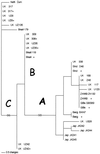Phylogenetic analysis of varicella-zoster virus: evidence of intercontinental spread of genotypes and recombination
- PMID: 11799191
- PMCID: PMC135920
- DOI: 10.1128/jvi.76.4.1971-1979.2002
Phylogenetic analysis of varicella-zoster virus: evidence of intercontinental spread of genotypes and recombination
Abstract
A heteroduplex mobility assay was used to identify variants of varicella-zoster virus circulating in the United Kingdom and elsewhere. Within the United Kingdom, 58 segregating sites were found out of the 23,266 examined (0.25%), and nucleotide diversity was estimated to be 0.00063. These are an order of magnitude smaller than comparable estimates from herpes simplex virus type 1. Sixteen substitutions were nonsynonymous, the majority of which were clustered within surface-expressed proteins. Extensive genetic correlation between widely spaced sites indicated that recombination has been rare. Phylogenetic analysis of varicella-zoster viruses from four continents distinguished at least three major genetic clades. Most geographical regions contained only one of these three strains, apart from the United Kingdom and Brazil, where two or more strains were found. There was minimal genetic differentiation (one or fewer substitutions in 1,895 bases surveyed) between the samples collected from Africa (Guinea Bissau, Zambia) and the Indian subcontinent (Bangladesh, South India), suggesting recent rapid spread and/or low mutation rates. The geographic pattern of strain distribution would favor a major influence of the former. The genetic uniformity of most virus populations makes recombination difficult to detect. However, at least one probable recombinant between two of the major strains was found among the samples originating from Brazil, where mixtures of genotypes co-occur.
Figures


Similar articles
-
Pangaea and the Out-of-Africa Model of Varicella-Zoster Virus Evolution and Phylogeography.J Virol. 2012 Sep;86(18):9558-65. doi: 10.1128/JVI.00357-12. Epub 2012 Jul 3. J Virol. 2012. PMID: 22761371 Free PMC article. Review.
-
Genetic variation of varicella-zoster virus: evidence for geographical separation of strains.J Med Virol. 2003;70 Suppl 1:S42-7. doi: 10.1002/jmv.10319. J Med Virol. 2003. PMID: 12627486
-
Different genotype pattern of varicella-zoster virus obtained from patients with varicella and zoster in Germany.J Med Virol. 2007 Jul;79(7):1025-31. doi: 10.1002/jmv.20879. J Med Virol. 2007. PMID: 17516537
-
Monitoring prevalence of varicella-zoster virus clades in Germany.Med Microbiol Immunol. 2011 May;200(2):99-107. doi: 10.1007/s00430-010-0178-6. Epub 2010 Oct 31. Med Microbiol Immunol. 2011. PMID: 21072536
-
VZV molecular epidemiology.Curr Top Microbiol Immunol. 2010;342:15-42. doi: 10.1007/82_2010_9. Curr Top Microbiol Immunol. 2010. PMID: 20229231 Review.
Cited by
-
Preliminary investigation and analysis of nucleotide site variability of nine glycoproteins on varicella-zoster virus envelope, Jilin Province, China, 2010-March 2024.Sci Rep. 2024 Oct 1;14(1):22758. doi: 10.1038/s41598-024-73072-w. Sci Rep. 2024. PMID: 39353981 Free PMC article.
-
Herpes simplex virus-1 and varicella-zoster virus latency in ganglia.J Neurovirol. 2003 Apr;9(2):194-204. doi: 10.1080/13550280390194000. J Neurovirol. 2003. PMID: 12707850 Review.
-
Analysis of equid herpesvirus 1 strain variation reveals a point mutation of the DNA polymerase strongly associated with neuropathogenic versus nonneuropathogenic disease outbreaks.J Virol. 2006 Apr;80(8):4047-60. doi: 10.1128/JVI.80.8.4047-4060.2006. J Virol. 2006. PMID: 16571821 Free PMC article.
-
Differentiation between wild-type and vaccines strains of varicella zoster virus (VZV) based on four single nucleotide polymorphisms.Epidemiol Infect. 2017 Sep;145(12):2618-2625. doi: 10.1017/S0950268817001509. Epub 2017 Jul 27. Epidemiol Infect. 2017. PMID: 28748773 Free PMC article.
-
Pangaea and the Out-of-Africa Model of Varicella-Zoster Virus Evolution and Phylogeography.J Virol. 2012 Sep;86(18):9558-65. doi: 10.1128/JVI.00357-12. Epub 2012 Jul 3. J Virol. 2012. PMID: 22761371 Free PMC article. Review.
References
-
- Adams, S. G., D. E. Dohner, and L. D. Gelb. 1989. Restriction fragment differences between the genomes of the Oka varicella vaccine virus and American wild-type varicella-zoster virus. J. Med. Virol. 29:38-45. - PubMed
-
- Arvin, A. M., C. M. Koropchak, and A. E. Wittek. 1983. Immunologic evidence of reinfection with varicella-zoster virus. J. Infect. Dis. 148:200-205. - PubMed
-
- Barrett-Muir, W., K. Hawrami, J. Clarke, and J. Breuer. 2001. Investigation of varicella-zoster virus variation by heteroduplex mobility assay. Arch. Virol. 17(Suppl. 1):17-25. - PubMed
-
- Breuer, J. 1997. Oka vaccine for VZV. Herpes 4:62-67.
Publication types
MeSH terms
LinkOut - more resources
Full Text Sources
Medical

